Intel Rocket Lake (14nm) Review: Core i9-11900K, Core i7-11700K, and Core i5-11600K
by Dr. Ian Cutress on March 30, 2021 10:03 AM EST- Posted in
- CPUs
- Intel
- LGA1200
- 11th Gen
- Rocket Lake
- Z590
- B560
- Core i9-11900K
CPU Tests: Encoding
One of the interesting elements on modern processors is encoding performance. This covers two main areas: encryption/decryption for secure data transfer, and video transcoding from one video format to another.
In the encrypt/decrypt scenario, how data is transferred and by what mechanism is pertinent to on-the-fly encryption of sensitive data - a process by which more modern devices are leaning to for software security.
Video transcoding as a tool to adjust the quality, file size and resolution of a video file has boomed in recent years, such as providing the optimum video for devices before consumption, or for game streamers who are wanting to upload the output from their video camera in real-time. As we move into live 3D video, this task will only get more strenuous, and it turns out that the performance of certain algorithms is a function of the input/output of the content.
HandBrake 1.32: Link
Video transcoding (both encode and decode) is a hot topic in performance metrics as more and more content is being created. First consideration is the standard in which the video is encoded, which can be lossless or lossy, trade performance for file-size, trade quality for file-size, or all of the above can increase encoding rates to help accelerate decoding rates. Alongside Google's favorite codecs, VP9 and AV1, there are others that are prominent: H264, the older codec, is practically everywhere and is designed to be optimized for 1080p video, and HEVC (or H.265) that is aimed to provide the same quality as H264 but at a lower file-size (or better quality for the same size). HEVC is important as 4K is streamed over the air, meaning less bits need to be transferred for the same quality content. There are other codecs coming to market designed for specific use cases all the time.
Handbrake is a favored tool for transcoding, with the later versions using copious amounts of newer APIs to take advantage of co-processors, like GPUs. It is available on Windows via an interface or can be accessed through the command-line, with the latter making our testing easier, with a redirection operator for the console output.
We take the compiled version of this 16-minute YouTube video about Russian CPUs at 1080p30 h264 and convert into three different files: (1) 480p30 ‘Discord’, (2) 720p30 ‘YouTube’, and (3) 4K60 HEVC.
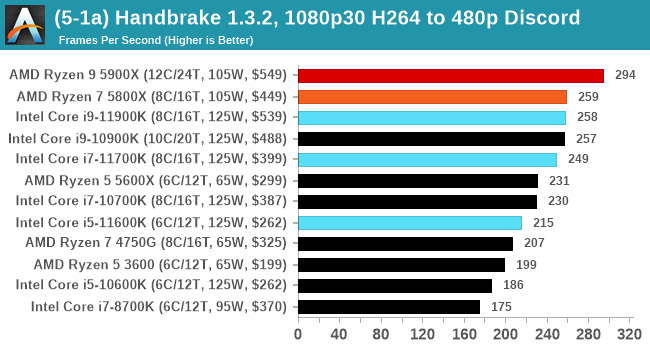
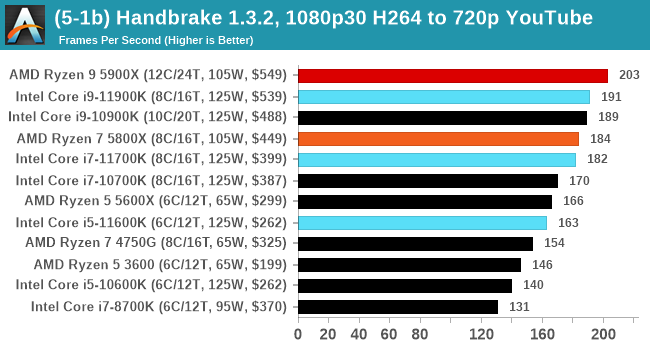
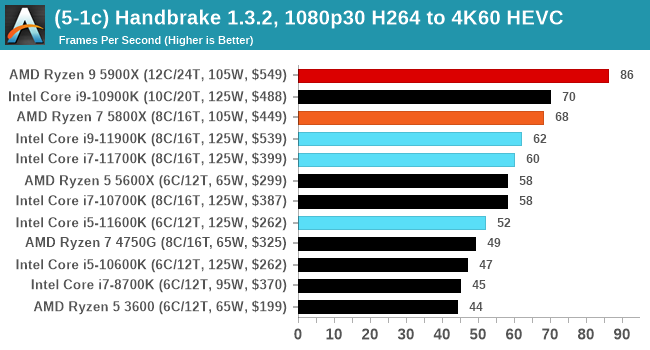
Up to the final 4K60 HEVC, in CPU-only mode, the Intel CPU puts up some good gen-on-gen numbers.
7-Zip 1900: Link
The first compression benchmark tool we use is the open-source 7-zip, which typically offers good scaling across multiple cores. 7-zip is the compression tool most cited by readers as one they would rather see benchmarks on, and the program includes a built-in benchmark tool for both compression and decompression.
The tool can either be run from inside the software or through the command line. We take the latter route as it is easier to automate, obtain results, and put through our process. The command line flags available offer an option for repeated runs, and the output provides the average automatically through the console. We direct this output into a text file and regex the required values for compression, decompression, and a combined score.
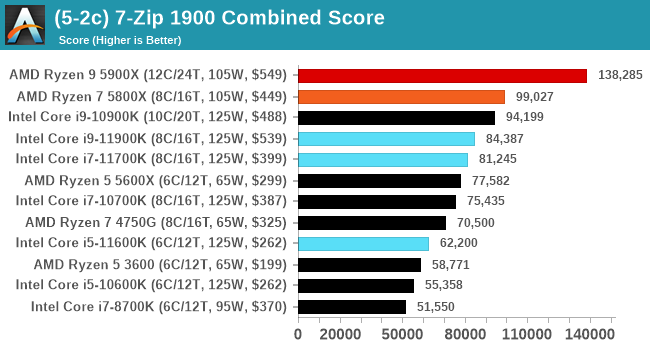
AES Encoding
Algorithms using AES coding have spread far and wide as a ubiquitous tool for encryption. Again, this is another CPU limited test, and modern CPUs have special AES pathways to accelerate their performance. We often see scaling in both frequency and cores with this benchmark. We use the latest version of TrueCrypt and run its benchmark mode over 1GB of in-DRAM data. Results shown are the GB/s average of encryption and decryption.
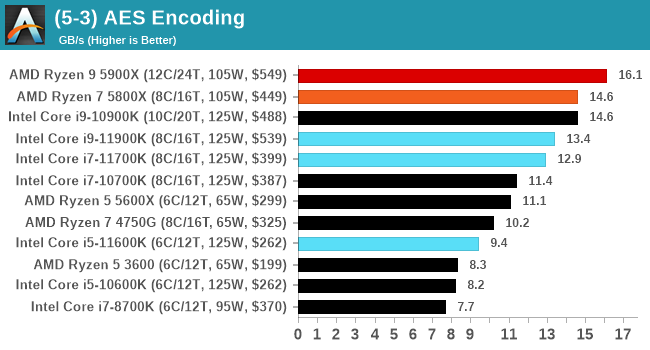
WinRAR 5.90: Link
For the 2020 test suite, we move to the latest version of WinRAR in our compression test. WinRAR in some quarters is more user friendly that 7-Zip, hence its inclusion. Rather than use a benchmark mode as we did with 7-Zip, here we take a set of files representative of a generic stack
- 33 video files , each 30 seconds, in 1.37 GB,
- 2834 smaller website files in 370 folders in 150 MB,
- 100 Beat Saber music tracks and input files, for 451 MB
This is a mixture of compressible and incompressible formats. The results shown are the time taken to encode the file. Due to DRAM caching, we run the test for 20 minutes times and take the average of the last five runs when the benchmark is in a steady state.
For automation, we use AHK’s internal timing tools from initiating the workload until the window closes signifying the end. This means the results are contained within AHK, with an average of the last 5 results being easy enough to calculate.
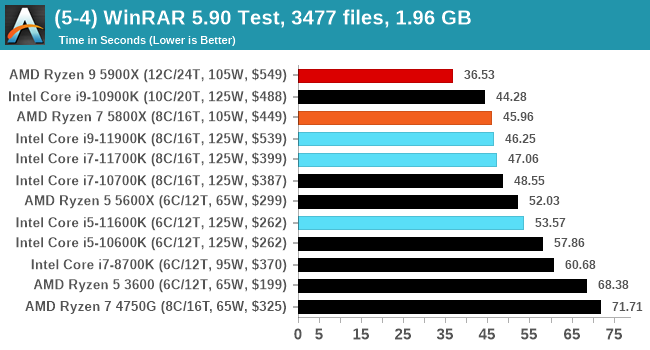
CPU Tests: Synthetic
Most of the people in our industry have a love/hate relationship when it comes to synthetic tests. On the one hand, they’re often good for quick summaries of performance and are easy to use, but most of the time the tests aren’t related to any real software. Synthetic tests are often very good at burrowing down to a specific set of instructions and maximizing the performance out of those. Due to requests from a number of our readers, we have the following synthetic tests.
Linux OpenSSL Speed: SHA256
One of our readers reached out in early 2020 and stated that he was interested in looking at OpenSSL hashing rates in Linux. Luckily OpenSSL in Linux has a function called ‘speed’ that allows the user to determine how fast the system is for any given hashing algorithm, as well as signing and verifying messages.
OpenSSL offers a lot of algorithms to choose from, and based on a quick Twitter poll, we narrowed it down to the following:
- rsa2048 sign and rsa2048 verify
- sha256 at 8K block size
- md5 at 8K block size
For each of these tests, we run them in single thread and multithreaded mode. All the graphs are in our benchmark database, Bench, and we use the sha256 results in published reviews.
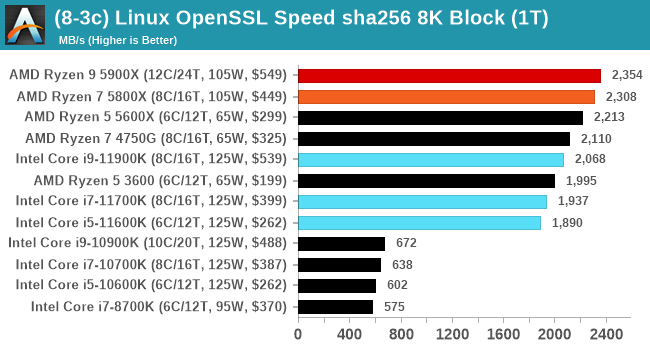
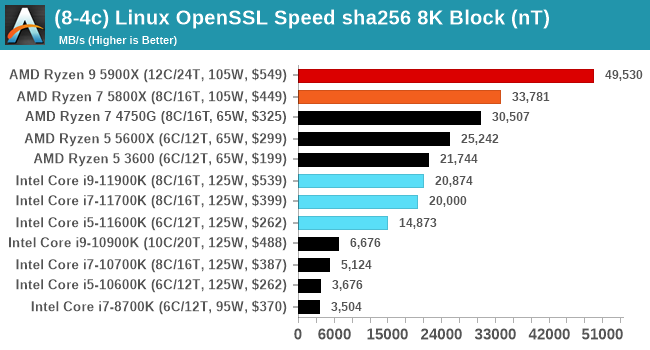
Intel comes back into the game in our OpenSSL sha256 test as the AVX512 helps accelerate SHA instructions. It still isn't enough to overcome the dedicated sha256 units inside AMD.
CPU Tests: Legacy and Web
In order to gather data to compare with older benchmarks, we are still keeping a number of tests under our ‘legacy’ section. This includes all the former major versions of CineBench (R15, R11.5, R10) as well as x264 HD 3.0 and the first very naïve version of 3DPM v2.1. We won’t be transferring the data over from the old testing into Bench, otherwise it would be populated with 200 CPUs with only one data point, so it will fill up as we test more CPUs like the others.
The other section here is our web tests.
Web Tests: Kraken, Octane, and Speedometer
Benchmarking using web tools is always a bit difficult. Browsers change almost daily, and the way the web is used changes even quicker. While there is some scope for advanced computational based benchmarks, most users care about responsiveness, which requires a strong back-end to work quickly to provide on the front-end. The benchmarks we chose for our web tests are essentially industry standards – at least once upon a time.
It should be noted that for each test, the browser is closed and re-opened a new with a fresh cache. We use a fixed Chromium version for our tests with the update capabilities removed to ensure consistency.
Mozilla Kraken 1.1
Kraken is a 2010 benchmark from Mozilla and does a series of JavaScript tests. These tests are a little more involved than previous tests, looking at artificial intelligence, audio manipulation, image manipulation, json parsing, and cryptographic functions. The benchmark starts with an initial download of data for the audio and imaging, and then runs through 10 times giving a timed result.
We loop through the 10-run test four times (so that’s a total of 40 runs), and average the four end-results. The result is given as time to complete the test, and we’re reaching a slow asymptotic limit with regards the highest IPC processors.

Google Octane 2.0
Our second test is also JavaScript based, but uses a lot more variation of newer JS techniques, such as object-oriented programming, kernel simulation, object creation/destruction, garbage collection, array manipulations, compiler latency and code execution.
Octane was developed after the discontinuation of other tests, with the goal of being more web-like than previous tests. It has been a popular benchmark, making it an obvious target for optimizations in the JavaScript engines. Ultimately it was retired in early 2017 due to this, although it is still widely used as a tool to determine general CPU performance in a number of web tasks.
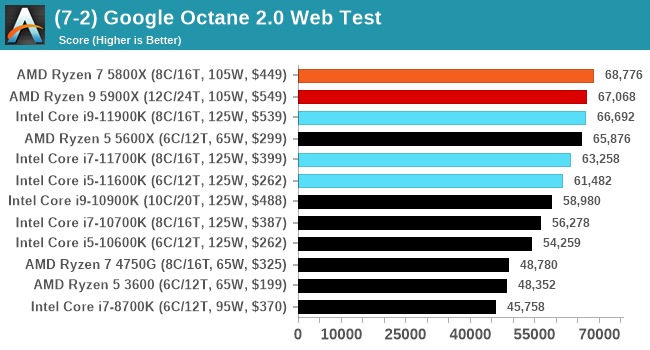
Speedometer 2: JavaScript Frameworks
Our newest web test is Speedometer 2, which is a test over a series of JavaScript frameworks to do three simple things: built a list, enable each item in the list, and remove the list. All the frameworks implement the same visual cues, but obviously apply them from different coding angles.
Our test goes through the list of frameworks, and produces a final score indicative of ‘rpm’, one of the benchmarks internal metrics.
We repeat over the benchmark for a dozen loops, taking the average of the last five.
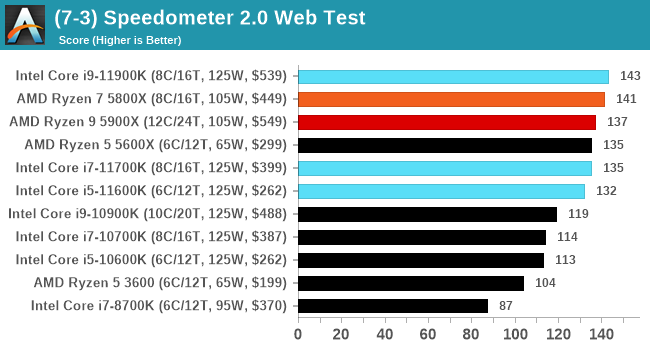
Legacy Tests
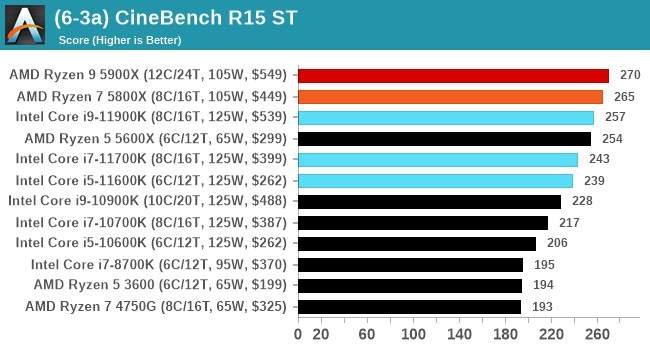

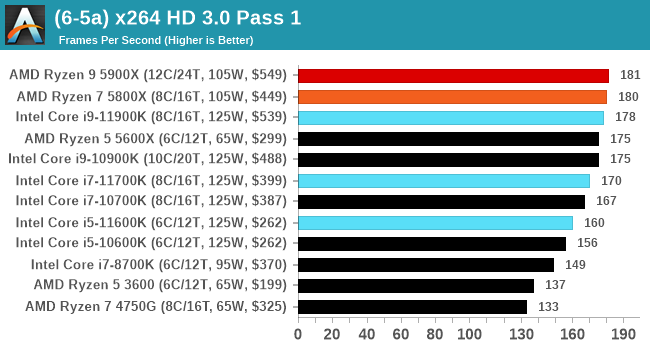
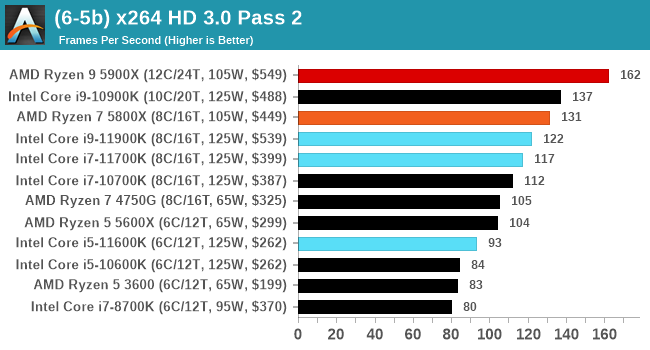


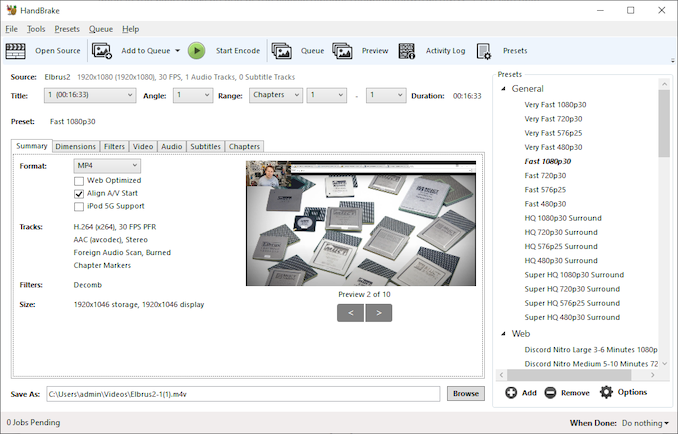
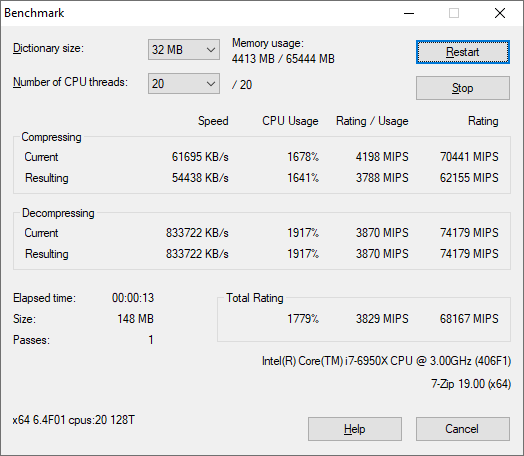
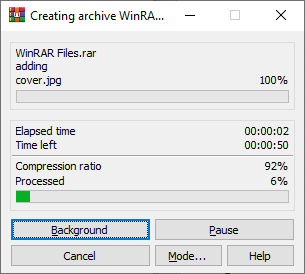

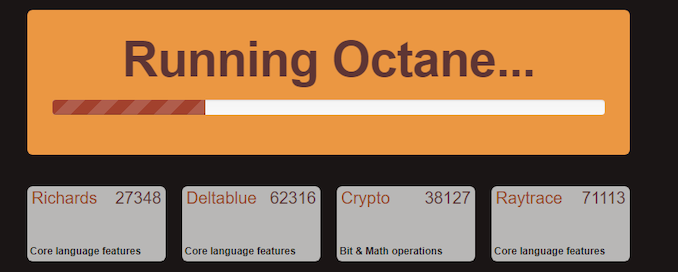
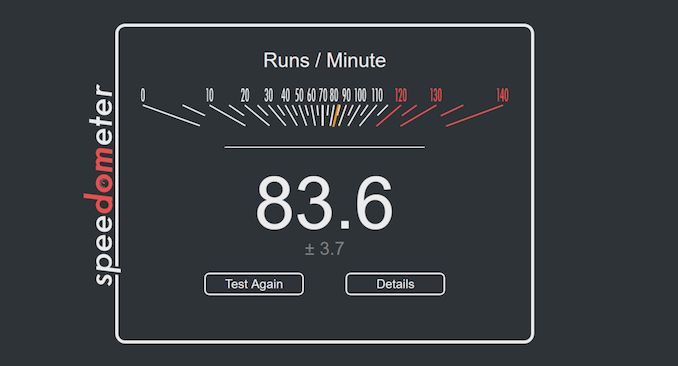








279 Comments
View All Comments
Qasar - Thursday, April 1, 2021 - link
" calling out Intel shills when I see them " ahh so you are calling out your self then ?the point you are making, is more like your own OPINION then any thing else. while YOU may not see the point in getting a cheap vid card so you can at least use the over all better cpu ( zen 3) then this dud, others may be fine with it. a few people i work with, are currently waiting for zen 3 to be in stock, and will upgrade to it, they have seen the reviews of rocket lake, and have no issues waiting, cause they know they will still be getting the better cpu.
" then there is zero value in any AMD CPU currently. " again YOUR opinion.
vanish1 - Friday, April 2, 2021 - link
Youre cherry picking words from my overall statement, nice try Intel shill. IF YOU ARE BUILDING A NEW PC RIGHT NOW THERE IS ZERO VALUE IN AMD CPUS. Some people actually care about spending their money frugally, not having to spend hundreds of dollars on a GPU they dont want just to make their CPU work.Beyond that, if E-peen matters so much to you and money is no object then why waste your cash in the first place on E-waste GPU, isnt it even more baller to buy a GPU when its most expensive? If you care so much about having the BEST cpu that does the BEST in every benchmark, how dare you grace its presence with such a lowly dGPU like a rx550 or gtx970? Hmmm conflict of interest, picks and chooses what part of the GPU crisis to support instead of skipping it completely.
Sorry you two, some of us live in the real world where money matters more than E-peen and video gaming addictions.
Qasar - Friday, April 2, 2021 - link
and you are trying to make an argument that so far, only YOU seem to be making, on here, and on other sites. YOU are the intel shill here, not me, nice try, if i was an intel shill would i be calling rocket lake a dud, or the better cpu being Zen 3 ? " IF YOU ARE BUILDING A NEW PC RIGHT NOW THERE IS ZERO VALUE IN AMD CPUS " and its YOUR opinion, plain and simple, while YOU see no value in them, i'd guess others see A LOT more value in them, then rocket lake." not having to spend hundreds of dollars on a GPU they dont want just to make their CPU work. " ahh so now, 50 bucks is hundreds if dollars ? and its doubtful someone buying the top, lets say 2 rocket lake cpus, is going to then use the IGP to play games on, that are recent, come on, get real.
with the way you keep crying about a 50 buck gpu being ewaste, you must have a comp that is quite old, so you can flex you own epeen, and not contribute e waste your self.
the fact that you are now, resorting to insults and name calling, proves nothing more then the fact you are probable just a child, have a good day, and i hope your old comp doesnt die on you, so you have to contribute to e waste yourself.
BushLin - Friday, April 2, 2021 - link
vanish1: OMG ewaste! OMG be frugal with money...Also vanish1: advocates buying 200w CPU on 6 year old 14nm process and a new motherboard which won't support future 10nm/7nm CPUs. Delivering about half the performance per watt of current AMD CPUs and needs custom water cooling or datacentre loud fans just to do that.
You're either an Intel shareholder, somehow trying to justify to yourself your bad purchase or just... you know, dumb.
vanish1 - Friday, April 2, 2021 - link
@qasar go home bud, you lost the argument days ago.@bushlin ahhh you, the shill, continues to spread FUD. You know nanometer size isnt a 1:1 standard across the industry right? https://www.youtube.com/watch?v=ROS008Av4E4 Linus is asking you sit down now please.
Beyond that, most people actually use their computer for longer than a product cycle and could really care less what cpu upgrade path exists, if you genuinely think 5 years from now a 6 or 8 core processor will be out of date then you need to seriously need to get your head checked. PC industry standards move independently of each category. You think SK Hynix cares about Intel and AMDs CPU upgrade paths when theyre ready to push DDR5 onto the world? (the answer is no).
11600k + mobo + money in my pocket = winning
5600x + mobo - overpriced dGPU to make it work = losing
BushLin - Friday, April 2, 2021 - link
" You know nanometer size isnt a 1:1 standard across the industry right?"Yes, obviously since I talked about *future* 10nm/7nm CPUs which only applies to Intel's metric as TSMC are knocking out 7nm Zen3 and 5nm Apple SoCs.
"11600k + mobo + money in my pocket = winning"
You have an office PC for a couple of years, by the time GPU shortages end you've got a terrible value for money, inefficient platform to slot a GPU into; by then, the same money you spent today would buy you a 5nm/3nm CPU with better IPC, DDR5 and even bigger gulf in performance per watt compared to your space heater, factory overclocked build.
Qasar - Friday, April 2, 2021 - link
sounds more like you lost the argument as i have suggested counter point to you BS claims about ewaste and such. bottom line is, from what it sounds like you only prefer the intel cpus, cause of the iGPU, which is fine but there ARE other options, its just you sound to cheap to consider them. a discrete vid card, can and could be used in pretty much any comp, so its not a waste as you claim.11600k + mobo + money in my pocket = winning
5600x + mobo - overpriced dGPU to make it work = losing
this is YOUR opinion nothing more.
29a - Friday, April 2, 2021 - link
I just bought a brand new AMD processor.vanish1 - Monday, April 5, 2021 - link
https://youtu.be/KPgmeNstLa8?t=722Where the clip starts the first guy has a Ryzen system sitting unused, using his phone instead.
The next one after, same situation no GPU, but Intel build, and look its running.
step back fade away J for the win at the buzzer.....swooshhhhhh
vanish1 - Monday, April 5, 2021 - link
Seriously; outside of work, do not support the GPU industry currently in any form, shape, or manner.